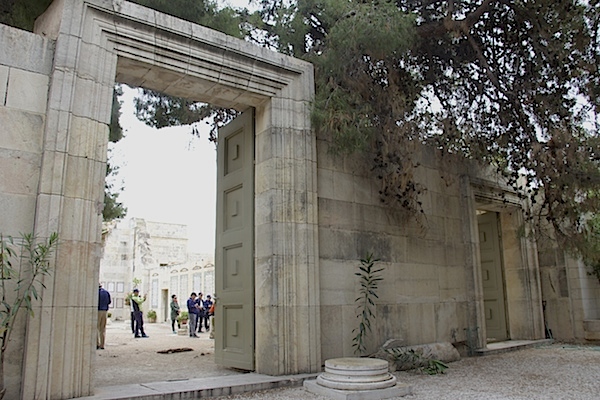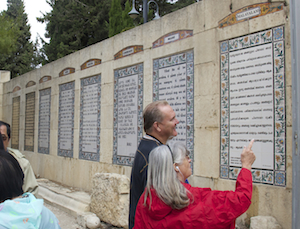
Church of the Pater Noster, Jerusalem
Ancient documents speak of a cave on the Mt. of Olives near the outskirts of Jerusalem that is associated with the teachings of Jesus.
In the early fourth century, St. Helen visited the Holy Land, and, with the help of the local community, identified this cave as an important place where Jesus gathered his followers. She led the building of a large church here; its sanctuary covered this cave.
Persians destroyed the church in 614, but the location was remembered as the place where Jesus taught the Our Father to his followers. Crusaders built a place of prayer here in 1106, and records from that time indicate that the oratory displayed inscriptions of the Lord’s Prayer in Hebrew, Latin, and Greek.
 In 1872, a Carmelite monastery was built here that preserved and restored the foundations of Helen’s church. The image above shows those open walls and a doorway. Today, the site displays in tile wall hangings the Our Father prayer in more than 100 languages, such as Tagalog, Aramaic, Lakota Sioux, and Hebrew.
In 1872, a Carmelite monastery was built here that preserved and restored the foundations of Helen’s church. The image above shows those open walls and a doorway. Today, the site displays in tile wall hangings the Our Father prayer in more than 100 languages, such as Tagalog, Aramaic, Lakota Sioux, and Hebrew.
The location of this site is only a few hundred feet away from the chapel of the Ascension, where the disciples last saw Jesus as he rose into heaven (see it on a map here). It would have been a natural place for those early followers to return for prayer—it is close to where they would have last physically seen Jesus. It also would have been a quiet, hidden place—a cool respite from the sun and the heat—where they had spent time with him, listening to him teach. It feels like a snug, safe hideout.
In fact, this cave served as a secret gathering place for early believers. The first generation of Jesus’ followers would have faced opposition from the Jewish community and the Romans for continuing to believe in Jesus and follow his teachings. This was a safe, secret place for them to come together to pray and remember him.
The Our Father is recorded in Scripture in two Gospels: Matthew 6:9-13, and Luke 11:1-4. In Luke's account, before Jesus teaches this prayer, he spends time in prayer, himself: “he was praying in a certain place.” If we consider this “certain place” as being this cave on the Mt. of Olives, we can see that this hill played an important role in Jesus’ own prayer life:
- It was a familiar place of rest: the cave is located on a route he would have traveled often between Jerusalem and Bethany, where he frequently visited his good friends, Martha, Mary, and Lazarus.
- It was a quiet place to get a new perspective: the hill overlooks Jerusalem (Jesus would have had views of the Temple from this area), and would have offered a refreshing and reflective “God’s eye” view of a bustling, crowded, politically-charged city.
- And we know that Jesus went to this hill in his hour of greatest need—his agony in the Garden of Gethsemane happened just at the bottom of the hill from this cave.
To stand in this cave, where some of the first Christians gathered to hear Jesus teach, is to touch and share their faithfulness. It is sometimes hard for us to identify with Jesus as he is revealing the Father to us; perhaps we can more easily relate to those first believers who found in Jesus an answer to the most important question of their lives, and clung to him. In this cave, we can almost feel their longing for God, their confidence in Jesus, and their resilience after he had risen. We don’t know who many of these first believers were, but we have them to thank for following his way and passing on to others what they had learned, particularly this most important prayer in which we learn to approach God as a Father.
The video below will allow you to step into this cave with a group of Notre Dame pilgrims to hear Father Pat Reidy, CSC, proclaim the Gospel where Jesus teaches us the Our Father.
Gospel Passages Associated with this Site
Mt 6:7-15
Lk 11:1-4